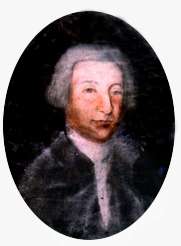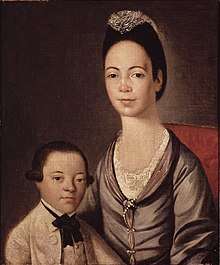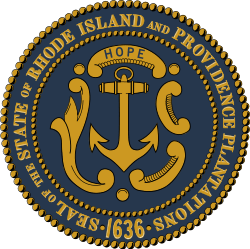Aaron Lopez
Aaron Lopez (1731–1782), born Duarte Lopez, was an Anglo-Portuguese Jewish slave trader, merchant, and philanthropist. Through his varied commercial ventures, he became the wealthiest person in Newport, Rhode Island, in British America. In 1761 and 1762, Lopez unsuccessfully sued the Colony of Rhode Island for citizenship.
Aaron Lopez | |
|---|---|
 | |
| Born | 1731 Lisbon, Portugal |
| Died | May 28, 1782 Newport, Rhode Island |
| Resting place | Newport, Rhode Island |
| Nationality | Portuguese, British |
| Occupation | Merchant, slave trader |
Early life
Duarte Lopez was born in 1731 in Lisbon, Portugal.[1] He belonged to a family of conversos, ethnically Jewish people who had converted to Catholicism, although the family continued to practice Judaism in secret.[2] In 1750 Lopez married a woman named Anna, and within two years the couple had a daughter, Catherine.[1]
Aaron's older brother José had left Portugal years earlier, reclaimed his Jewish identity, and taken the name Moses.[1] Moses was naturalized in 1740 and granted a license by the General Assembly to make potash in 1753, and he became a successful merchant in Newport.[3] In 1752 Duarte and his family moved to Newport, where they too reclaimed their Jewish identities and became Aaron, Abigail, and Sarah.[1][4]
Business

Lopez established himself as a shopkeeper in Newport shortly after his arrival. By 1755 he was buying and selling goods throughout Rhode Island and dealing with agents in Boston and New York.[5]
One of Lopez's early business interests was the trade-in spermaceti, a coveted wax extracted from whale oil used to make elegant candles. Lopez built a candle-making factory in Newport in 1756. By 1760, a dozen competitors had built similar plants in New England. Whalers couldn't supply the factories with enough spermaceti to meet the demand, and the price of whale oil was climbing. In 1761, Lopez joined eight other merchants to form a trust to control the cost and distribution of whale oil.[6]
Lopez expanded his trade beyond the North American coastline and by 1757 had major interests in the West Indian trade.[7] He also sent ships to Europe and the Canary Islands.[8] Between 1761 and 1774, Lopez was involved in the slave trade.[9] Historian Eli Faber determined Lopez underwrote 21 slave ships during a period in which Newport sent a total of 347 slave ships to Africa.[10] By the beginning of the American Revolution, Lopez owned or controlled 30 vessels, engaged in the European and West-Indian trade and in whale-fisheries. [11]
By the early 1770s, Lopez had become the wealthiest person in Newport; his tax assessment was twice that of any other resident.[12][13] The reason he was successful was that his business interests were so diverse. He manufactured spermaceti candles, ships, barrels, rum, and chocolate. He had business interests in the production of textiles, clothes, shoes, hats, and bottles.[14] Ezra Stiles, the Congregational minister in Newport and future president of Yale College, described Lopez as "a merchant of the first eminence" and wrote that the "extent of [his] commerce probably [was] surpassed by no merchant in America".[15]
In the mid-1770s, with growing tensions between Britain and its American colonies, Lopez's fortunes began to decline. The Continental Association enforced a boycott against trade with Britain. In October 1775, the British navy anchored outside Newport's harbour and the population began to evacuate the city. In early 1776 Lopez relocated to Portsmouth, Rhode Island, then to Providence, Boston, and finally to Leicester, Massachusetts. Historian Marilyn Kaplan describes Lopez's losses during the American Revolution as "monumental."[16]
Philanthropy
Lopez supported a number of charitable causes in Newport. He purchased books for the Redwood Library and Athenaeum. He contributed lumber to help build the College in the English Colony of Rhode Island and Providence Plantations (which later relocated to Providence and eventually became Brown University),[17] and he donated land to establish Leicester Academy in Leicester, Massachusetts.
Lopez was a leading contributor who helped build the Touro Synagogue, and he was given the honor of laying one of its cornerstones.[18][19]
During the American Revolution, Lopez harbored Jewish refugees in his Leicester home. Referring to those sheltered by Lopez, a friend wrote in jest that "your family at present are in a number only 99 and still there is room for one more".[20]
Citizenship
In 1761, Lopez applied to the Rhode Island Superior Court to become a naturalized citizen.[2] Under Britain's Naturalization Act of 1740, any foreign Protestant who had resided in the American colonies for seven years could become a British citizen; while Catholics were excluded by the law, special provisions were allowed for the religious scruples of both Quakers and Jews. Although he met the conditions set by law, Lopez's request was denied.[21] Another qualified Jew, Isaac Elizer, was also denied citizenship.[2][22]
Lopez and Elizer appealed to the Rhode Island General Assembly. The lower house approved their request and required that the men return to the Superior Court to take an oath of allegiance, but the terms of their citizenship would be limited: Jews could become citizens of Rhode Island, but they would not be allowed to vote or serve in public office.[23]
Lopez and Elizer fared worse in the upper house of the legislature. There they were told that Parliament had given the courts, not the legislature, jurisdiction over naturalization. If they wished to become citizens, Lopez and Elizer would have to appeal to the Superior Court.[24]
The Superior Court heard the pair's appeal on March 11, 1762. Their application was denied a second time. The court reasoned that the 1740 act was intended to increase the population of the colony, and since the colony had grown crowded the law no longer applied. The court also noted that under a 1663 Rhode Island law, only Christians could become citizens.[25] Lopez and Elizer could not become citizens of Rhode Island.[22][24][26]
Determined to become a citizen, Lopez made inquiries to learn whether he could become naturalized in another colony. In April 1762 he moved temporarily to Swansea, Massachusetts.[24] On October 15, 1762, Lopez became a citizen of Massachusetts and then returned to Newport. Historians believe Lopez was the first Jew to become a naturalized citizen of Massachusetts.[27]
Death
On May 28, 1782, while returning with his family from Leicester to Newport, he drowned when his horse and carriage fell into a pond.[28][29] He was buried in the Jewish cemetery in Newport.[30][31]
See also
- Jewish history in Colonial America
- Judaism and slavery
References
- "Guide to the Papers of Aaron Lopez (1731–1782)". American Jewish Historical Society. September 2017. Retrieved September 29, 2018.
- Feldberg, p. 12.
- Schappes, p. 573, citing Morris A. Gutstein, The Story of the Jews of Newport (New York: Block Publishing Co., 1936), pp. 55, 306.
- Kaplan, p. 13.
- Kaplan, p. 18.
- Kaplan, pp. 18–19.
- Schappes, p. 58.
- Kaplan, p. 19.
- Friedman, pp. 123–127.
- Faber, p. 138.
- Jacobs, et al., p. 294.
- Davis, Paul (March 13, 2006). "Plantations in the North: The Narragansett Planters". The Providence Journal. Archived from the original on March 15, 2006. Retrieved May 11, 2008.
- Pencak, p. 88.
- Kaplan, p. 21.
- Marcus and Saperstein, p. 94.
- Kaplan, p. 22.
- Pencak, p. 92.
- Pencak, p. 95.
- Brody, Seymour (1996). "Aaron Lopez - Merchant King Who Kept The Revolutionary Army Supplied". Jewish Heroes and Heroines in America from Colonial Times to 1900. Florida Atlantic University Libraries. Archived from the original on May 17, 2008. Retrieved May 11, 2008.
- Pencak, p. 100.
- No record of the decision has survived, so the court's rationale is unknown. Feldberg, p. 12.
- Smith and Sarna, p. 3.
- Feldberg, pp. 12-13.
- Feldberg, p. 13.
- According to Marcus and Saperstein, the law was enacted around 1699, not 1663 (p. 93).
- Marcus and Saperstein, pp. 92–93.
- Marcus and Saperstein, p. 92.
- Marcus and Saperstein, pp. 94–95.
- Pencak, p. 109.
- Jacobs, et al., p. 295.
- Marcus and Saperstein, p. 95.
Sources
- Faber, Eli (1998). Jews, Slaves, and the Slave Trade: Setting the Record Straight. New York: New York University Press. ISBN 0-8147-2638-0.
- Feldberg, Michael, ed. (2002). "Aaron Lopez's Struggle for Citizenship". Blessings of Freedom: Chapters in American Jewish History. New York: American Jewish Historical Society. ISBN 0-88125-756-7.
- Friedman, Saul S. (1998). Jews and the American Slave Trade. New Brunswick, N.J.: Transaction Publishers. ISBN 0-7658-0660-6.
- The Historical Research Department of the Nation of Islam (1991). The Secret Relationship Between Blacks and Jews. Chicago: Latimer Associates. ISBN 0-9636877-0-0.
- Jacobs, Joseph; L. Hühner; Max J. Kohler (1906). "Newport". In Isidore Singer; Cyrus Adler (eds.). Jewish Encyclopedia. New York: Funk & Wagnalls. Retrieved May 11, 2008.
- Kaplan, Marilyn (2004). "The Jewish Merchants of Newport, 1749–1790". In George M. Goodwin; Ellen Smith (eds.). The Jews of Rhode Island. Waltham, Mass.: Brandeis University Press. ISBN 1-58465-424-4.
- Marcus, Jacob Rader; Marc Saperstein (1999) [1983]. "Rhode Island Refuses to Naturalize Aaron Lopez, March 1762". The Jew in the Medieval World: A Source Book, 315–1791. Cincinnati: Hebrew Union College Press. ISBN 0-87820-217-X.
- Pencak, William (2005). Jews & Gentiles in Early America: 1654–1800. Ann Arbor, Mich.: University of Michigan Press. ISBN 0-472-11454-9.
- Smith, Ellen; Jonathan D. Sarna (2004). "Introduction: The Jews of Rhode Island". In George M. Goodwin; Ellen Smith (eds.). The Jews of Rhode Island. Waltham, Mass.: Brandeis University Press. ISBN 1-58465-424-4.
Further reading
- Bigelow, Bruce M. (October 1931). "Aaron Lopez: Colonial Merchant of Newport". The New England Quarterly. IV (4): 757–776. doi:10.2307/359587. JSTOR 359587.
- Chyet, Stanley F. (1970). Lopez of Newport: Colonial American Merchant Prince. Detroit: Wayne State University Press. ISBN 0-8143-1407-4.
- Gutstein, Morris Aaron (1939). Aaron Lopez and Judah Touro: A Refugee and a Son of a Refugee. New York: Behrman's Jewish Book House. OCLC 2848361.
- Schappes, Morris U. (1976) [1950]. "Merchant in Exile". In Morris U. Schappes (ed.). A Documentary History of the Jews of the United States 1654-1875. New York: Schocken Books. ISBN 0-8052-0488-1.
External links
- Snyder, Holly; Elder, Tanya; Lang, Leanora (eds.). "Guide to the Papers of Aaron Lopez (1731-1782), 1752-1794, 1846, 1852, 1953 P-11". Center for Jewish History. Retrieved August 16, 2018.
